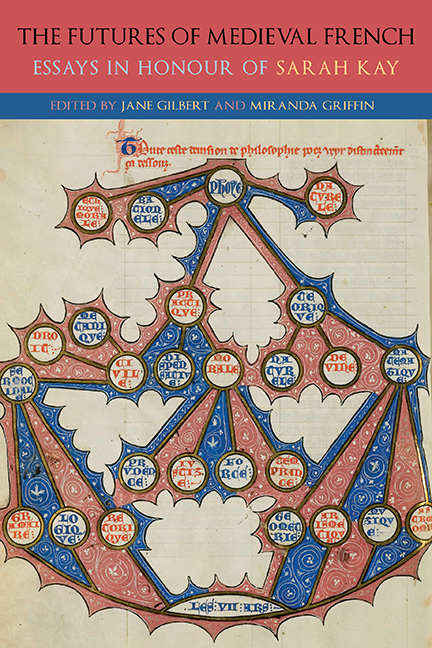Book contents
- Frontmatter
- Dedication
- Contents
- List of Illustrations
- List of Contributors
- List of Abbreviations
- Introduction
- Part I Subjectivity in Troubadour Poetry
- Part II The ‘Chansons de geste’ in the Age of Romance: Political Fictions
- Part III Courtly Contradictions: The Emergence of the Literary Object in the Twelfth Century
- Part IV The Place of Thought: The Complexity of One in French Didactic Literature
- Part V Parrots and Nightingales: Troubadour Quotations and the Development of European Poetry
- Part VI Animal Skins and the Reading Self in Medieval Latin and French Bestiaries
- Afterword
- General Bibliography
- List of Manuscripts
- Bibliography of Work by Sarah Kay
- Index
- Gallica
Forms of Repetition: Sestinas in the Twenty-First Century
Published online by Cambridge University Press: 27 May 2021
- Frontmatter
- Dedication
- Contents
- List of Illustrations
- List of Contributors
- List of Abbreviations
- Introduction
- Part I Subjectivity in Troubadour Poetry
- Part II The ‘Chansons de geste’ in the Age of Romance: Political Fictions
- Part III Courtly Contradictions: The Emergence of the Literary Object in the Twelfth Century
- Part IV The Place of Thought: The Complexity of One in French Didactic Literature
- Part V Parrots and Nightingales: Troubadour Quotations and the Development of European Poetry
- Part VI Animal Skins and the Reading Self in Medieval Latin and French Bestiaries
- Afterword
- General Bibliography
- List of Manuscripts
- Bibliography of Work by Sarah Kay
- Index
- Gallica
Summary
PARROTS AND NIGHTINGALES is a bold move against Romantic and post-Romantic aesthetics of inspiration in at least three respects. First, Sarah Kay devotes the bulk of her monograph to ‘didactic’ literature, often regarded as of low literary value. Secondly, when she discusses poets and works whose literary worth is recognised, she treats them as eminently ‘didactic’, highlighting how their poetry is quoted as a vehicle for teaching or conveying knowledge, and the desire for knowledge. Finally, Kay discusses repetition while distinguishing between citation and quotation. Her attention is focused not just on literary allusion (citation), which has come in for a good deal of analysis, but also on the much less discussed verbatim repetition (quotation) of prior material, or parroting. In this essay I shall focus on a different kind of repetition: the reproduction of a clearly recognisable and unique literary form, in this instance the sestina. The sestina is a particularly interesting case study because repetition is also its structural pillar: it is defined by the repetition of a unique metrical and rhetorical principle, namely the end-word. In this essay I shall discuss sestinas composed in the English language between 2000 and 2019, focusing on the debt these poems – and this genre – owe to medieval troubadour poetics.
This essay revolves around three main topics. Firstly, it is well established that metrical imitation combined with variation is a key component of troubadour poetics. At the same time, the particular formal complexity and rigidity of the sestina make it a limit case, so that, in this instance at least, metrical imitation becomes a form of radical citation or even quotation, to the extent that the distinction between imitation and quotation/citation becomes blurred. Secondly, Kay claims in Parrots and Nightingales that the quotation practices that characterised early reception of the troubadours were foundational of the European vernacular poetic tradition: the continued reproduction today of the sestina, a form that was pioneered and most likely invented by Arnaut Daniel, the celebrated late twelfth-century ‘best craftsman of the vernacular tongue’ (as Dante was to label him), demonstrates the extent to which literary culture is still determined by these quotation practices.
- Type
- Chapter
- Information
- The Futures of Medieval FrenchEssays in Honour of Sarah Kay, pp. 264 - 280Publisher: Boydell & BrewerPrint publication year: 2021



